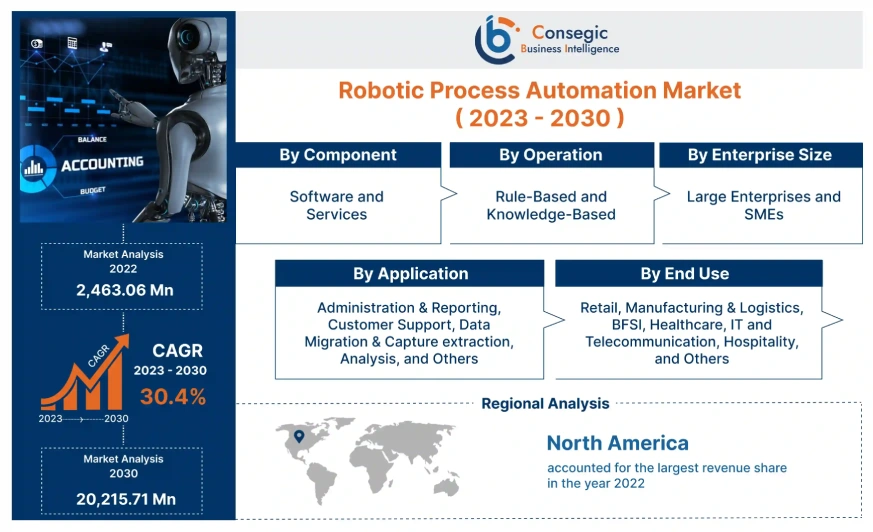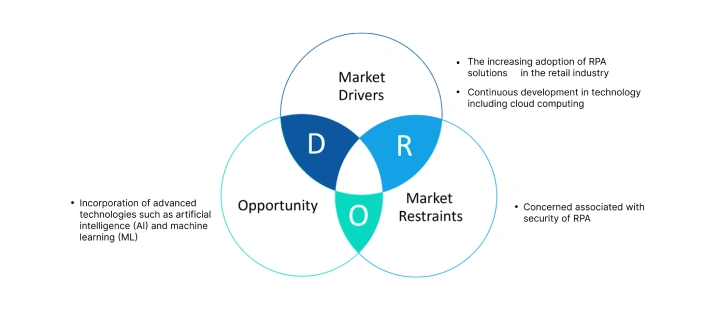Robotic Process Automation (RPA) Market Size :
Robotic Process Automation (RPA) Market size is estimated to reach over USD 20,215.71 Million by 2030 from a value of USD 2,463.06 Million in 2022, growing at a CAGR of 30.4% from 2023 to 2030
Robotic Process Automation (RPA) Market Scope & Overview :
Robotic Process Automation (RPA) is a technology that uses software robots to automate repetitive and rule-based tasks that are typically handled by people. RPA robots mimic human actions such as logging into applications, entering data, and clicking on buttons, and work continuously without breaks or errors. RPA is used to streamline and automate back-office tasks such as data entry, invoice processing, and report generation. Moreover, RPA is used in customer-facing processes such as order processing and customer service to accelerate the growth of robotic process automation market.
Robotic Process Automation (RPA) Market Insights :
Key Drivers :
Growing adoption of RPA solutions in the retail industry
The increasing adoption of RPA solutions in the retail industry to improve efficiency and productivity of operations is driving the growth of robotic process automation market. RPA solutions are used to automate various supply chain operations such as inventory management, order processing, and supplier management. Moreover, RPA is used to automate customer-facing tasks such as customer service, online ordering, and delivery tracking, thereby providing a better customer experience. Consequently, RPA is used to automate various back-office operations such as data entry and invoicing, thereby reducing errors and improving the efficiency of different processes. For instance, in March 2021, ABB implemented IRB 660 robot for various tasks such as palletizing, packing, and material handling at Nestlé's Brazilian plants. Therefore, the implementation of RPA solutions in retail industries results in increased efficiency and productivity, leading to the growth of robotic process automation market.
Continuous development in technology including cloud computing
By automating tasks that are performed by humans, organizations reduce the need for manual labor and associated costs. RPA also helps businesses reduce errors and improve the accuracy of their operations, leading to further cost savings. For instance, in March 2021, Deloitte announced a collaboration with Automation Anywhere to accelerate cloud intelligent automation adoption to help organizations automate their processes and increase efficiency while leveraging the power of the cloud and artificial intelligence (AI).
Key Restraints :
Concerned associated with security of RPA
The implementation of RPA solutions requires significant upfront investment in software and consulting costs. As a result, organizations with limited budgets are unable to invest in advanced RPA solutions. Moreover, RPA solutions potentially create security concerns, particularly for industries dealing with sensitive data, such as financial or healthcare organizations. Thus, the security concerns associated with RPA solutions along with its high maintenance costs are restraining the growth of the robotic process automation market.
Future Opportunities :
Incorporation of advanced technologies such as artificial intelligence (AI) and machine learning (ML)
The integration of advanced technologies such as artificial intelligence (AI) and machine learning (ML) with RPA solutions is expected to present potential opportunities for the growth of robotic process automation (RPA) market. The incorporation of advanced technologies allows RPA solutions to learn from data, identify patterns, and make decisions to improve business outcomes. For instance, in August 2020, Infosys launched an AI-driven solution called ‘the Cognitive Email Workbench' to automate helpdesk operations. The application of intelligent automation solutions is expected to create significant growth opportunities for the robotic process automation market.
Robotic Process Automation (RPA) Market Report Insights :
| Report Attributes | Report Details |
| Study Timeline | 2017-2030 |
| Market Size in 2030 (USD Billion) | USD 20,215.71 Million |
| CAGR (2023-2030) | 30.4% |
| Base Year | 2022 |
| By Component | Software and Services |
| By Operation | Rule-Based and Knowledge-Based |
| By Enterprise Size | Large Enterprises and SMEs |
| By Application | Administration & Reporting, Customer Support, Data Migration & Capture extraction, Analysis, and Others |
| By End-User | Retail, Manufacturing & Logistics, BFSI, Healthcare, IT & Telecommunication, Hospitality, and Others |
| By Geography | Asia-Pacific, Europe, North America, South America, Middle East & Africa |
| Key Players | Automation Anywhere, Blue Prism Group PLC, UiPath Inc., Microsoft Corporation, Nice Systems Ltd., WorkFusion, Inc., Pegasystems, Inc., OnviSource, Inc., Salesforce (Servicetrace GmbH/Mulesoft, Inc.), Kryon Systems |
Robotic Process Automation (RPA) Market Segmental Analysis
By Component :
Based on the component, the market is bifurcated into software and services. The software segment accounted for the largest revenue share in the year 2022. The increasing demand for automation in industries such as manufacturing, retail, and healthcare is driving the growth of software segment. RPA software is used to automate a wide range of business processes, including data entry, invoice processing, customer service, and supply chain management. Moreover, RPA software platforms include drag-and-drop interfaces for building automation workflows, bots for executing automated tasks, and analytics tools for monitoring and optimizing business performance. In conclusion, the growing demand for automation in industries to increase the efficiency of business processes is driving the growth of robotic process automation market.
The services segment is expected to register the fastest CAGR growth during the forecast period. Organizations require support in identifying and prioritizing processes for automation such as designing, implementing, and maintaining automation solutions. The services segment provides consulting, implementation, and support services to help organizations achieve their automation goals. For instance, in December 2022, the Service Automation Framework Alliance (SAFA) launched a new product level for the Service Automation Framework (SAF) called the Robotic Process Automation Foundation (RPAF) to provide a uniform approach to RPA implementation, thereby allowing organizations to adopt and scale RPA solutions.
By Operation :
Based on the operation, the market is divided into rule-based and knowledge-based. The rule-based segment accounted for the largest revenue share in the year 2022. Rule-based RPA solutions are cost-effective and easier to deploy as they involve tasks that have well-defined processes and workflows to automate repetitive tasks. Therefore, rule-based RPA solutions are well-suited for automating tasks such as data entry, invoice processing, and HR onboarding. Moreover, rule-based RPA solutions are implemented without major changes to existing IT systems or processes, thereby allowing businesses to quickly adapt to the new systems. For instance, in June 2022, MuleSoft launched the rule based MuleSoft RPA Ecosystem to provide organizations with a comprehensive set of tools and capabilities to automate business processes.
The knowledge-based segment is expected to emerge as the fastest-growing segment during the forecast period. Knowledge-based RPA solutions provide greater accuracy and efficiency thereby helping businesses to make informed decisions. Knowledge-based RPA solutions use artificial intelligence (AI) technologies to analyze and interpret data and make decisions based on that analysis. Consequently, knowledge-based RPA is used to automate complex tasks that involve unstructured data, such as document processing, customer service, and fraud detection. As a result, the ability of knowledge-based RPA to handle complex business processes to provide accuracy is contributing to the growth of robotic process automation market.
By Enterprise Size :
Based on the enterprise size, the market is bifurcated into large enterprises and SMEs. The large enterprise segment accounted for the largest revenue share in the year 2022. Large enterprises have more complex business processes than small and medium-sized enterprises (SMEs), thereby requiring more automation to improve efficiency and reduce costs. RPA solutions help businesses to streamline and automate complex processes to enhance the overall productivity of the business.
Moreover, large enterprises have greater resources, including funding, infrastructure, and staff, dedicated to implementing RPA solutions. For instance, in August 2022, Automation Anywhere launched a new contact center solution aimed at empowering enterprises to deliver faster and better service. In conclusion, the adoption of RPA solutions by large enterprises to increase the productivity and efficiency of the processes is driving the growth of robotic process automation market.
The SMEs segment is anticipated to witness the fastest CAGR growth during the forecast period. SMEs are becoming aware of the benefits of RPA solutions, such as cost savings, improved productivity, and reduced errors. As a result, SMEs are investing in RPA solutions to improve the business processes. Moreover, RPA solutions are becoming easily accessible for SMEs, requiring minimal IT resources and technical expertise. As a result, the affordability and the ease of deployment of RPA solutions is contributing to the growth of robotic process automation market during the forecast period.
By Application :
Based on the application, the market is segregated into administration & reporting, customer support, data migration & capture extraction, analysis, and others. The administration & reporting segment accounted for the largest revenue share of 27.85% in the year 2022. Administration and reporting involve a range of repetitive and time-consuming tasks such as data entry, invoice processing, and report generation. RPA solutions automate such tasks, enabling organizations to improve operational efficiency, thereby leading to better decision-making and improved customer satisfaction.
The analysis segment is expected to register the fastest CAGR growth during the forecast period. The increasing need for complex data analysis is driving the growth of robotic process automation market. The growing volume of data requires advanced analytics capabilities to derive insights and make informed decisions. RPA solutions automate data extraction and analysis, enabling organizations to gain valuable insights and improve the decision-making processes. As a result, RPA solutions are used for data analysis tasks, such as predictive modeling and forecasting to improve the overall outcome of the businesses. For instance, in August 2021, Wipro Limited collaborated with HERE Technologies to offer location-based services and analytics in the areas of asset tracking, logistics, supply chain, smart-metering and analytics. Thus, the increasing demand for data analysis and the need for specialized expertise is driving the growth of robotic process automation market.
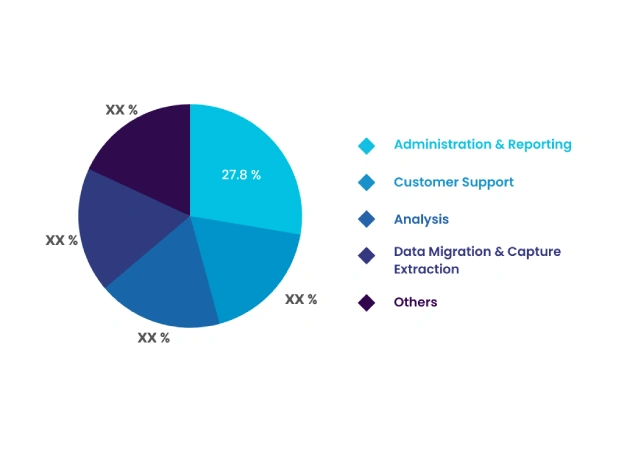
By End-User :
Based on the end-user, the market is segmented into retail, manufacturing & logistics, BFSI, healthcare, IT & telecommunication, hospitality, and others. The BFSI segment accounted for the largest revenue share in the year 2022. The BFSI sector has a high volume of repetitive, rule-based processes that are well-suited for automation. As a result, the BFSI industry is adopting RPA solutions to automate the processes such as account opening, data entry, and payment processing, and others.
The healthcare industry is expected to witness the fastest CAGR growth during the forecast period. The increasing demand for cost-effective and efficient healthcare services is driving the growth of robotic process automation (RPA) market. RPA helps to automate repetitive and manual tasks such as patient record keeping, claims processing, and billing, thereby reducing administrative costs and improving the accuracy and speed of the processes. For instance, in March 2022, SS&C Technologies Holdings, Inc. acquired Blue Prism Group Plc to expand its automation services and software capabilities across healthcare and financial services sectors. Moreover, the increasing adoption of electronic health records (EHRs) in healthcare industry is further driving the growth of robotic process automation market.
By Region :
The regional segment includes North America, Europe, Asia Pacific, Middle East and Africa, and Latin America.
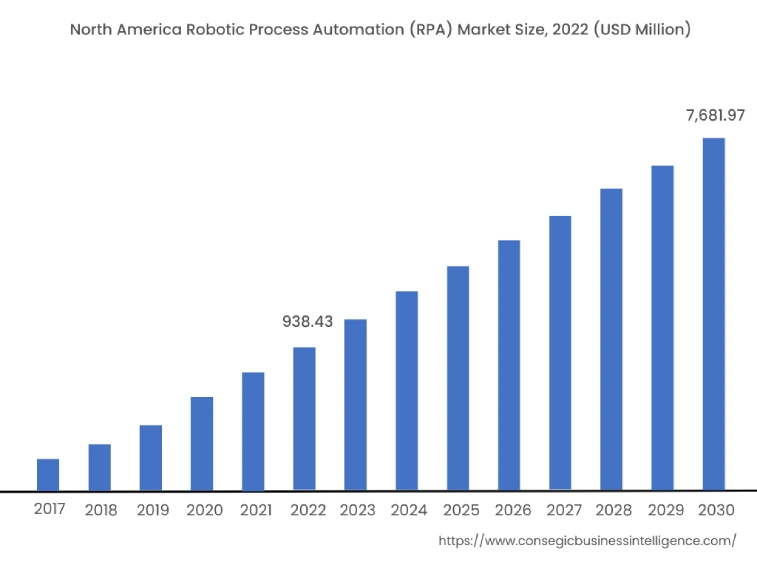
North America accounted for the largest revenue share in the year 2022 valued at USD 938.43 million and is projected to grow at a CAGR of 30.3% during the forecast period. In addition, in the region, United States accounted for the maximum revenue share of 42.7% in the year 2022. The high demand for automation in North America due to the need for improved efficiency, increased productivity, and reduced operational costs is driving the growth of robotic process automation market. Moreover, North America has a high adoption rate of advanced technologies such as artificial intelligence (AI) and machine learning (ML) that further accelerate the growth of the robotic process automation market. Additionally, key players such as Automation Anywhere, UiPath Inc., and Microsoft Corporation in the region are constantly driving innovation and developing new RPA solutions, leading to the expansion of the market. For instance, in March 2021, Microsoft Corporation launched robotic process automation for its Windows 10 users to help automate repetitive tasks.
The Asia-Pacific region is anticipated to witness the fastest CAGR of 31.1% during the forecast period. The increasing adoption of automation and digital transformation initiatives by organizations in various industries such as BFSI, healthcare, manufacturing, and retail is driving the growth of robotic process automation market. Moreover, the growing need for cost-effective and efficient business processes is driving the demand for RPA solutions in the region. Therefore, the increasing demand for automation along with several initiatives to digitalize operations in various industries is contributing to the growth of the robotic process automation market.
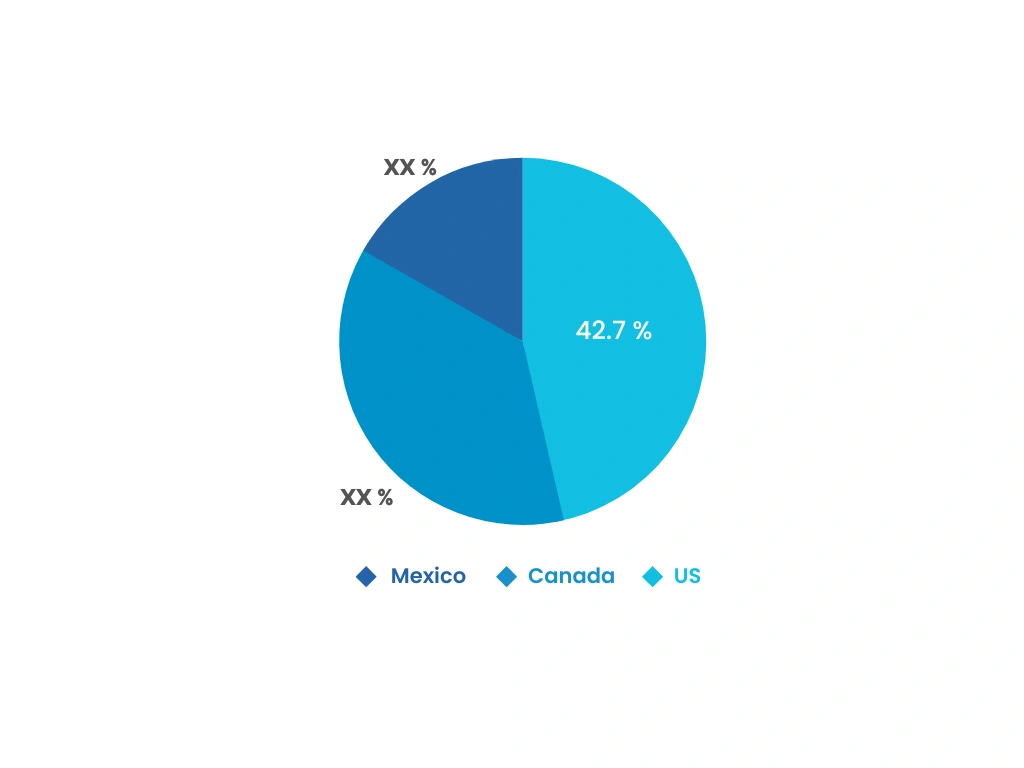
Top Key Players & Market Share Insights :
The competitive landscape of the robotic process automation market has been analyzed in the report, along with the detailed profiles of the major players operating in the industry. Further, the surge in Research and Development (R&D), product innovation, various business strategies, and application launches have accelerated the growth of the robotic process automation market. Key players in the robotic process automation market include -
- Automation Anywhere
- Blue Prism Group PLC
- UiPath Inc.
- Microsoft Corporation
- Nice Systems Ltd.
- WorkFusion, Inc.
- Pegasystems, Inc.
- OnviSource, Inc
- Kryon Systems
Recent Industry Developments :
- In March 2021, Amentum partnered with UiPath to launch a Center of Excellence (CoE) focused to provide the benefits of automation to mission-critical customers.
- In November 2020, Pegasystems, Inc. announced the launch of robotic process automation (RPA) auto-balancing feature in Pega Platform featuring artificial intelligence to balance the workloads without human intervention.
Key Questions Answered in the Report
What is Robotic Process Automation (RPA)? +
Robotic Process Automation (RPA) is a technology that uses software robots to automate repetitive and rule-based tasks that are typically handled by people. RPA robots mimic human actions such as logging into applications, entering data, and clicking on buttons, and work continuously without breaks or errors.
What specific segmentation details are covered in the Robotic Process Automation (RPA) market report, and how is the dominating segment impacting the market growth? +
The report consists of segments including Component, Operation, Enterprise Size, and End-User. Each segment has key dominating sub-segment being driven by the industry trends and market dynamics. For instance, by component has witnessed software as the dominating segment in the year 2022, driven by factors such as increasing demand for automation in industries such as manufacturing, retail, and healthcare.
What specific segmentation details are covered in the Robotic Process Automation (RPA) market report, and how is the fastest segment anticipated to impact the market growth? +
The report consists of segments including Component, Operation, Enterprise Size, and End-User. Each segment is projected to have the fastest growing sub-segment being fueled by industry trends and drivers. For instance, Enterprise Size, SMEs sub-segment is anticipated to witness the fastest CAGR growth during the forecast period. SMEs are becoming aware of the benefits of RPA solutions, such as cost savings, improved productivity, and reduced errors.
What specific segmentation details are covered in the Robotic Process Automation (RPA) market report, and how does each dominating segment is influencing the demand globally? +
As aforementioned, each dominating segment is influencing the demand globally due to growing industrial needs. Moreover, due to fluctuation in demand being witnessed from different sectors is accounted for driving the robotic process automation market.
